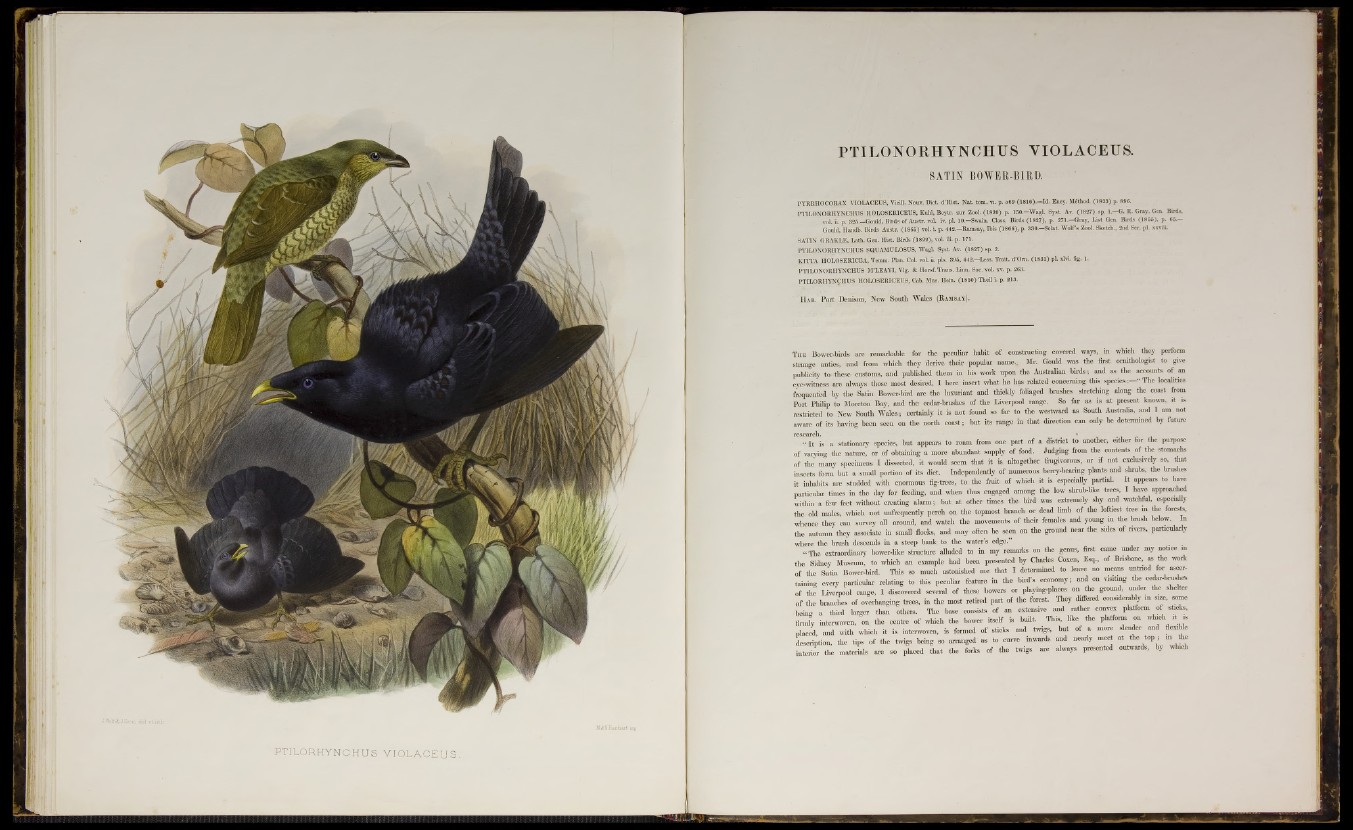
PTILORHYNCHUS VIOLACEUS,
PTILONORHYNCHUS YIOLACEUS.
SA T I I B0WER-B1RD.
PYRRHOCORAX VIOLACEUS, Vieill.Nouv. Diet. d’Hist. Nat. tom. vi. p. ¡>69 (1816).—Id. Ency. Method. (1823) p. 896.
PTILONORHYNCHUS HOLOSERICEUS, Kuhl, Beytr. zur Zool. (1820) p. 15 0—Wagl. S y s t Av. (1827) sp. 1.—G. R. Gray. Gen. Birds,
vol. ii,p i 325;-^Gdtfidi'Birds o f Austr. vol. iv. pl. 10.—Swain. Class. Birds (1827), p. 271.—Gray, List Gen. Birds (1 865), p. 65.—
Gould, Handb Birds Austr. (1865) vol. i. p. 442.—Ramsay, Ibis (1 866), p. 330.—Sclat. Wolf’s Zool. Sketch., 2nd Ser. pi. xxviii.
SATIN GRAKLE, Lath. Gen. Hist. Birds (1822), vol. iii. p. 171.
PTILONORHYNCHUS SQUAMULOSUS, WagL Syst. Av. (1827) sp. 2. ,
KITTA HOLOSERICEA, Temm. Plan. Col. vol. ii. pis. 395, 442.—Less. Trait. d’Om. (1831) pi. d v i. fig. 1.
PTILONORHYNCHUS M’LEAYI, Vig. & Horsf. Trans. Linn. Soc. vol. xv. p. 263.
PTILORHYNCHUS HOLOSERICEUS, Cab. Mus. Hein. (1 850) Theil i. p. 213.
'H a b . Port Denison, New South Wales (R am sa y ) .
T h e fioweribirds »re remarkable for the peculiar habit o f constructing covered ways, in which they perform
strange antics, and from which they derive their popular name.. Mr, Gould was the first ornithologist to give
publicity toi these customs, and published them in his work upon the Australian birds; and as : the accounts of an
eye-witness are always those most desired, I here insert what he has related concerning this s p e c i e s T b e localities
frequented by the Satin Bower-hird are the luxuriant and thickly foliaged brushes stretching along the coast from
Port Philip to Moreton Bay, and the cedar-brushes of the Liverpool range. So f a as is at present known, it is
restricted to New South Wales; certainly it is not. found so f a to the westward as South Australia, and I am not
aware of its having been seen on the north coast;, but its range in that direction can only be determined by fcture
research. *.
“ It is a stationary species, -but appears to roam from one part of a district to another, either for the purpose
of varying the nature, or of obtaining a more abundant supply of food. Judging from the contents of the stomachs
of the many specimens I dissected, it would seem that it is altogether frugivorous, or if not exclusively so, that
insects form but a small portion of its diet. Independently of numerous berry-hearing plants and shrubs, the brushes
it inhabits axe studded with enormous fig-trees, to the fruit of which it is especially partial. It appears to have
particular times in the day for feeding, and when thus engaged among the low shrub-like trees, I have approached
within a few feet without creating alarm; but, at other times the bird was extremely shy and watchful, especially
the old males, which not unfrequently perch on the topmost branch or dead limb of the loftiest tree in the forests,
whence they can survey all around, and watch the movements of their females and young in the brush below. In
the autumn they associate in small flocks, and may often he seen on the ground near the sides of nvers, particularly
where the brush descends in a steep hank to the water’s edge.”
“ The extraordinary bower-like structure alluded to in my remarks on the genus, first came under my notice in
the Sidney Museum, to which an example had been presented by Charles Coxen, Esq., of Brisbane, as the work
of the Satin Bower-bird. This so much astonished me that I determined to leave no means untried for ascer-
taining every particular relating to tins peculiar feature in the bird's economy; and on visiting the cedc-brushes
of the Liverpool range, I discovered several of these bowers or playing-places on the ground, under tbe shelter
o f the b ^ e b . . of overhanging trees, in the most retired psrt of the forest. They differed considerably m sme, some
being a third larger than others. The base consists of an extensive and rather convex platform of sticks,
firmly interwoven, on tbe centre of which tbe bower itself is built. This, like the platform on which rt »
placed and with which it is interwoven, is formed of sticks and twigs, but of a more slender and ffexrble
description, the tips of tbe twigs being so arranged as to curve inwards and nearly meet at the top ; m the
interior the materials are so placed . that the forks of the twigs are always presented outwards, by which